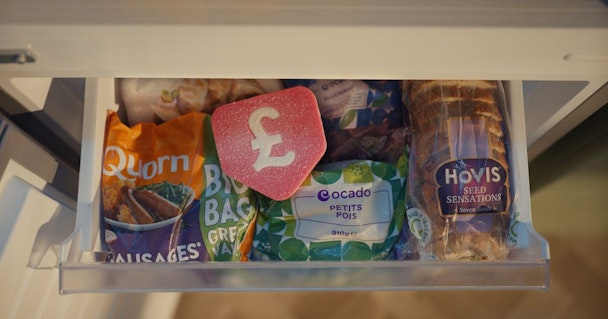Is price-obsessed marketing helpful or harmful to supermarket brands’ reputations?
Consumers have been hit with a barrage of price-matching and price-cut messaging by UK supermarkets this month. We ask retail experts if this tactic actually works.

Ocado reran its TV ad from last year that showed a woman getting buried alive by pound signs
January is a tough month financially for consumers, with a long wait for payday following the December splurge. In a bid to target these cash-strapped shoppers, UK supermarkets have been busy rolling out heavily price-focused campaigns.
Sainsbury’s ran an ad to challenge its pricey reputation and Morrisons’ ‘Price Locked Low’ campaign used padlocks to show it wouldn’t raise prices.
Tesco, meanwhile, took out a front cover ad in The Metro newspaper to promote it had dropped the price of its own brand beans by 5p and Ocado reran its TV ad from last year that showed a woman getting buried alive by pound signs falling from her cupboard.
As an indicator of how grim things are here, Tesco is running a front page ad on the Metro promoting own brand tins of beans being 5p cheaper. pic.twitter.com/6FaHjeBcpR
— Andy Haigh (@Wolverinesclaws) January 11, 2024
Price-matching competitor supermarkets has also been prevalent this month in above-the-line campaigns and in-store. Even Aldi, one of the cheaper retailers, has in-store price-matching ads comparing its prices to Tesco.
Advertisement
Asda took the bold decision to announce a price match campaign across 287 grocery products, reducing prices by 17%. The retailer promoted the introduction of the scheme with a TV commercial and has rolled out significant in-store marketing.
The strategy has sparked debate over whether price matching is a valuable strategy or if it can cause more harm than good. Rob Sellers, ex-Grey and VCCP retail lead, says it is price “bonkers,” adding: “I just cannot see the intelligence of spending your advertising money on telling the world that Aldi and Lidl are really cheap.”
And Asda saying it is price-matching 287 grocery products means it is “basically saying is the other 10,000 products in its store are not matched,” explains Sellers. Instead, retailers should be focusing on what they can offer beyond prices, he says: for example, Sainsbury’s has a wide range of ingredients, M&S and Waitrose “do special really well,” while Co-op has its locality and community to lean into.
“What is great about Asda is that it is fucking massive, it does toys and fun clothing, it does world food really well. You can get everything for the family at Asda.
“The supermarkets all play different roles and they should just be themselves. They should be confident enough to talk about what makes them different in terms of the total value equation and then use price as a reassurance afterward.”
Advertisement
Observing Asda’s price match strategy, Ivo Petroff, category manager at Walmart Canada, believes it’s likely to cause concerns for investors and harm the balance sheet in the long term. “Matching is a lousy short-term Band-Aid at a high cost that is usually unsustainable.”
A key problem is that Aldi and Lidl have entirely different business models “engineered from inception” to deliver cheap prices, says Petroff, who has also worked for Target and Lidl.
Instead, he praises Marks and Spencer’s strategy for its “consistent core message” around quality. “Its evolution is affordability, but it has never crossed the line of price matching discounters or claiming the lowest price.” Conversely, for Asda, Petroff says a “lack of consistent identity and lack of strategy that supports this identity is a serious Achilles heel for any organization. Price or quality match is just surface.”
Suggested newsletters for you
The case for
Despite retail experts proclaiming that price matching is harmful in the long term, Bryan Roberts, the global insight lead at IGD, points to the fact that Tesco and Sainsbury’s have both concluded that their Aldi price-matching is a “tremendous success.” Tesco credited its price matching scheme with Aldi as a leading contributor to boosting its market share in its third quarter 2023 results.
“As part of a broader package of measures, such as loyalty pricing, everyday low prices and ‘price locks,’ price-matching is demonstrably successful as a reassurance for shoppers that they don’t need to go elsewhere to get low prices on the items that matter,” Roberts says.
It’s imperative, though, that Asda should support the price-matching with ongoing innovation in its Asda Rewards loyalty program and own label improvements, he adds. If Asda does these things, “there is no reason why it shouldn’t succeed with its new endeavor. Indeed, it wouldn’t be a great surprise to see other retailers following suit.”
There’s no specific evidence to show that price matching is driving footfall to certain brands. However, Fraser McKevitt, head of retail and consumer insight at Kantar, says that the retailer’s appetite for price matching is the indicator that they work. “[Price matching] is clearly seen by retailers as an incredibly important way to show shoppers how they are offering best value.
“Grocery is a highly competitive market, with consumers on average visiting more than three major supermarket brands in any given month, so the retailers really can’t afford to rest on their laurels.”

